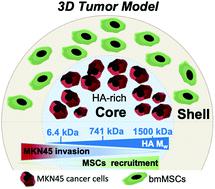当前位置:
X-MOL 学术
›
Biomater. Sci.
›
论文详情
Our official English website, www.x-mol.net, welcomes your feedback! (Note: you will need to create a separate account there.)
3D hydrogel mimics of the tumor microenvironment: the interplay among hyaluronic acid, stem cells and cancer cells
Biomaterials Science ( IF 6.6 ) Pub Date : 2020-10-28 , DOI: 10.1039/d0bm00843e Sara Amorim 1, 2, 3, 4, 5 , Diana Soares da Costa 1, 2, 3, 4, 5 , Iva Pashkuleva 1, 2, 3, 4, 5 , Celso A. Reis 6, 7, 8, 9, 10 , Rui L. Reis 1, 2, 3, 4, 5 , Ricardo A. Pires 1, 2, 3, 4, 5
Biomaterials Science ( IF 6.6 ) Pub Date : 2020-10-28 , DOI: 10.1039/d0bm00843e Sara Amorim 1, 2, 3, 4, 5 , Diana Soares da Costa 1, 2, 3, 4, 5 , Iva Pashkuleva 1, 2, 3, 4, 5 , Celso A. Reis 6, 7, 8, 9, 10 , Rui L. Reis 1, 2, 3, 4, 5 , Ricardo A. Pires 1, 2, 3, 4, 5
Affiliation

|
The present work reports on a 3D model of the tumor microenvironment that contains hyaluronic acid (HA) and alginate, and demonstrates the utility of this model to study the effect of HA size on the crosstalk between cancer cells and mesenchymal stem cells (MSCs). The system incorporates a core that contains HA of specific size (i.e. 6.4, 741 or 1500 kDa) with encapsulated epithelial MKN45 cancer cells and a shell with MSCs that mimic the presence of stem cells next to the tumor site. It was found that short HA (i.e. 6.4 kDa) promotes the invasion of cancer cells from the core to the shell, whereas longer HA (i.e. 741 and 1500 kDa) recruits the MSCs into the core, i.e. the tumor site, where a reduction of the formation of cancer cell aggregates was observed. In summary, the developed 3D model recapitulates some key tumor features related to the effect of HA size on both cancer cell invasiveness and MSC behavior at the tumor site.
中文翻译:

肿瘤微环境的3D水凝胶模拟物:透明质酸,干细胞和癌细胞之间的相互作用
本工作报告了包含透明质酸(HA)和藻酸盐的肿瘤微环境3D模型,并证明了该模型可用于研究HA尺寸对癌细胞与间充质干细胞(MSC)之间串扰的影响。该系统整合了一个核心,该核心包含特定大小的HA(即6.4、741或1500 kDa)和封装的上皮MKN45癌细胞,以及一个带有MSC的壳,该MSC模仿肿瘤部位附近的干细胞的存在。发现短的HA(即6.4 kDa)促进癌细胞从核心向壳的侵袭,而较长的HA(即741和1500 kDa)将MSC募集到核心,即在肿瘤部位,观察到癌细胞聚集体形成的减少。总之,开发的3D模型概括了与HA大小对肿瘤部位的癌细胞侵袭性和MSC行为的影响有关的一些关键肿瘤特征。
更新日期:2020-11-16
中文翻译:

肿瘤微环境的3D水凝胶模拟物:透明质酸,干细胞和癌细胞之间的相互作用
本工作报告了包含透明质酸(HA)和藻酸盐的肿瘤微环境3D模型,并证明了该模型可用于研究HA尺寸对癌细胞与间充质干细胞(MSC)之间串扰的影响。该系统整合了一个核心,该核心包含特定大小的HA(即6.4、741或1500 kDa)和封装的上皮MKN45癌细胞,以及一个带有MSC的壳,该MSC模仿肿瘤部位附近的干细胞的存在。发现短的HA(即6.4 kDa)促进癌细胞从核心向壳的侵袭,而较长的HA(即741和1500 kDa)将MSC募集到核心,即在肿瘤部位,观察到癌细胞聚集体形成的减少。总之,开发的3D模型概括了与HA大小对肿瘤部位的癌细胞侵袭性和MSC行为的影响有关的一些关键肿瘤特征。



























 京公网安备 11010802027423号
京公网安备 11010802027423号